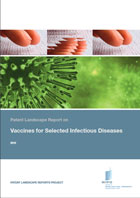Patent Landscape Report on Vaccines for Selected Infectious Diseases
Publication year: 2012
DOI: English

The scope of this report is to detect patterns of patenting activity and innovation in the area of vaccine research and manufacturing in order to facilitate the sourcing of vaccine technologies that could potentially be used in developing countries. Part I provides an overview of patenting activity in the area of vaccines by means of a statistical analysis. Part II focuses on the patenting related to vaccines for: streptococcus pneumonia conjugate vaccines; typhoid conjugate vaccines; and influenza vaccines. Each part of the report also includes a special focus on the patenting activity in Brazil, China and India.
- Topic: Public health
- Cooperation partners: World Health Organization (WHO)
A vaccine is defined by the World Health Organization (WHO) as any preparation intended to produce immunity to a disease by stimulating the production of antibodies. Vaccines include, for example, suspensions of killed or attenuated microorganisms, or products or derivatives of microorganisms. Vaccines are of public health importance since they prevent from major pandemics but not all. Therefore, the development of new vaccines is still required to combat diseases such as HIV or malaria, for example, but also to improve existing ones due to the emergence of new strains of pathogens such as for influenza.
The scope of this patent landscape report is to detect patterns of patenting activity and innovation in the area of vaccine research and manufacturing in order to facilitate the sourcing of vaccine technologies that could potentially be used in developing countries, via a comprehensive study of the patents and patent applications filed in this field. The scope of the present patent landscape report includes patent families that claim inventions directly related to vaccines, i.e. any patents that protect any aspect like the active ingredient (antigen, antibody) as such, derivatives thereof, combinations, methods of production, uses, etc.
A first part (part I) covers vaccines against infectious human and animal diseases in general. This part aims at providing an overview of patenting activity in the area of vaccines by means of a statistical analysis. A second part (part II) complements this broad picture by focusing separately on the patenting related to vaccines for three selected human infectious diseases of high economic and health burden importance: streptococcus pneumonia conjugate vaccines; typhoid conjugate vaccines; and influenza vaccines. In addition to describing the respective statistical patterns of patenting activity, this Part II of the report also aims at identifying all of the relevant patent families, and is complemented by respective databases including these patent families. Each part of the report also includes a special focus on the patenting activity in Brazil, China and India.
The present landscape report was prepared in collaboration with the WHO cluster on Innovation, Information, Evidence and Research (IER). It is intended to contribute to the implementation of several of the eight elements of the Global Strategy and Plan of Action on Public Health, Innovation and Intellectual Property (GSPOA) of WHO.